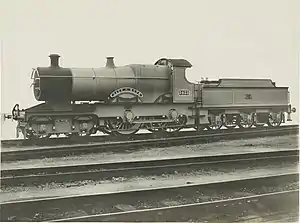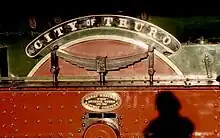| 3700 "City" class | |||||||||||||||||||||||||||||||||||||||||
|---|---|---|---|---|---|---|---|---|---|---|---|---|---|---|---|---|---|---|---|---|---|---|---|---|---|---|---|---|---|---|---|---|---|---|---|---|---|---|---|---|---|
 No. 3433, City of Bath | |||||||||||||||||||||||||||||||||||||||||
| |||||||||||||||||||||||||||||||||||||||||
| |||||||||||||||||||||||||||||||||||||||||
| |||||||||||||||||||||||||||||||||||||||||
| |||||||||||||||||||||||||||||||||||||||||
The Great Western Railway 3700 Class, or City Class, locomotives were a series of twenty 4-4-0 steam locomotives, designed for hauling express passenger trains.
Construction
In September 1902 a member of the Atbara Class, no. 3405 Mauritius, was reboilered with a tapered domeless boiler and Belpaire firebox. The locomotive was the first GWR 4-4-0 to be fitted with a tapered boiler; the boiler became the prototype for Churchward's Standard No. 4 boiler.[1] In March 1903 the first of the City Class, no. 3433 City of Bath, was completed.[2] It was fitted with the final form of the Standard No.4 boiler, with slightly curved sides and a tapered top to the firebox. Another nine locomotives were completed in May 1903.[2] Between February 1907 and December 1908, nine Atbaras were rebuilt with this boiler and incorporated into the City Class.[3] All members of the class were withdrawn between October 1927 and May 1931.[3][4]
Details
| First No | Second No | Name | Built | Rebuilt | Withdrawn | Notes |
|---|---|---|---|---|---|---|
| 3400 | 3700 | Durban | Aug 1901 | Apr 1907 | Nov 1929 | |
| 3401 | 3701 | Gibraltar | Aug 1901 | Feb 1907 | Aug 1928 | |
| 3402 | 3702 | Halifax | Aug 1901 | Dec 1908 | Apr 1929 | |
| 3403 | 3703 | Hobart | Sep 1901 | Feb 1909 | Aug 1929 | |
| 3404 | 3704 | Lyttleton | Sep 1901 | Oct 1907 | Sep 1928 | Renamed Lyttelton in June 1920 |
| 3405 | 3705 | Mauritius | Sep 1901 | Sep 1902 | Sep 1928 | |
| 3406 | 3706 | Melbourne | Sep 1901 | Jan 1908 | Jun 1929 | |
| 3407 | 3707 | Malta | Sep 1901 | Nov 1908 | Apr 1929 | |
| 3408 | 3708 | Ophir | Oct 1901 | May 1907 | Oct 1929 | Renamed Killarney in September 1907 |
| 3409 | 3709 | Quebec | Oct 1901 | Nov 1907 | Sep 1929 |
| First No | Second No | Name | Built | Withdrawn | Notes |
|---|---|---|---|---|---|
| 3433 | 3710 | City of Bath | Mar 1903 | Sep 1928 | |
| 3434 | 3711 | City of Birmingham | May 1903 | Jul 1930 | |
| 3435 | 3712 | City of Bristol | May 1903 | May 1931 | Last to be withdrawn |
| 3436 | 3713 | City of Chester | May 1903 | Dec 1929 | |
| 3437 | 3714 | City of Gloucester | May 1903 | Nov 1929 | |
| 3438 | 3715 | City of Hereford | May 1903 | Oct 1929 | |
| 3439 | 3716 | City of London | May 1903 | Apr 1929 | |
| 3440 | 3717 | City of Truro | May 1903 | Mar 1931 | Preserved |
| 3441 | 3718 | City of Winchester | May 1903 | Oct 1927 | First to be withdrawn |
| 3442 | 3719 | City of Worcester | May 1903 | Apr 1929 | Renamed City of Exeter |
Modifications
Superheating of the boiler was first applied to no. 3702, Halifax in June 1910. All of the class had been fitted with superheaters by 1912.[6] Boiler feed was originally by clack valves fitted to the underside of the barrel.[7] Top feed was introduced in 1912 and new cast iron chimneys in 1921. The slide valves were replaced by 8 in (20.3 cm) semi-plug piston valves from 1914.[6] All the engines were fitted with steam reversing gear but only a few, including no. 3716 City of London, had the gear replaced by the screw reverse. The Dean suspension bogie was replaced by a bogie developed from the type used on the de Glehn Atlantics.[8] Four retained the Dean bogies until withdrawal.
Accidents and incidents
- On 8 August 1913, locomotive No. 3710 City of Bath overran signals and was in a rear-end collision with a passenger train at Yeovil Pen Mill station, Somerset. Two people were killed.[9]
City of Truro

The most famous locomotive in the class, 3440 City of Truro (later renumbered 3717), is reputedly the first steam locomotive to travel in excess of 100 mph, on 9 May 1904.[10][notes 2] It was the 2000th locomotive to be built at Swindon, leaving the works in April 1903.[11]
Withdrawal
Withdrawal of the class began in 1927 with 3718 City of Winchester which was withdrawn in October 1927, the engines working life being only just over 24 years. Regular withdrawal of the class began in August of the following year and by July 1930 only two engines were left in service on the GWR, these being 3712 City of Bristol and 3717 City of Truro. 3717 was the first of the final two engines to be withdrawn as it was withdrawn in March 1931 & 3712 followed two months later in May of the same year.
Only one member of the class has survived into preservation, this being 3440/3717 City of Truro.
| Year | Quantity in service at start of year | Number withdrawn | Quantity withdrawn | Locomotive numbers |
|---|---|---|---|---|
| 1927 | 20 | 1 | 1 | 3718 |
| 1928 | 19 | 4 | 5 | 3701/04/05/10 |
| 1929 | 15 | 12 | 17 | 3700/02–03/06–09/13–16/19 |
| 1930 | 3 | 1 | 18 | 3711 |
| 1931 | 2 | 2 | 20 | 3712/17 |
Preservation
Historically significant because of its famed 1904 run, City of Truro was a prime candidate for preservation, whereas the rest of the class were scrapped. It is owned by the National Railway Museum, York. It was last restored to full working order in 2004 and, as of 2009, was frequently loaned for operation on UK main lines and heritage railways. As of 2021, 'City of Truro' is on static display.
List of Locomotives
This class were subject to the 1912 renumbering of GWR 4-4-0 locomotives, which saw the Bulldog class gathered together in the series 3300–3455, and other types renumbered out of that series. The City Class took numbers 3700–3719, previously used by Bulldog locomotives.[12]
| Numbers | Name | ||
|---|---|---|---|
| First | Second (1912) | First | Second |
| 3400 | 3700 | Durban | |
| 3401 | 3701 | Gibraltar | |
| 3402 | 3702 | Halifax | |
| 3403 | 3703 | Hobart | |
| 3404 | 3704 | Lyttelton | |
| 3405 | 3705 | Mauritius | |
| 3406 | 3706 | Melbourne | |
| 3407 | 3707 | Malta | |
| 3408 | 3708 | Ophir | Killarney |
| 3409 | 3709 | Quebec | |
| 3433 | 3710 | City of Bath | |
| 3434 | 3711 | City of Birmingham | |
| 3435 | 3712 | City of Bristol | |
| 3436 | 3713 | City of Chester | |
| 3437 | 3714 | City of Gloucester | |
| 3438 | 3715 | City of Hereford | |
| 3439 | 3716 | City of London | |
| 3440 | 3717 | City of Truro | |
| 3441 | 3718 | City of Winchester | |
| 3442 | 3719 | City of Worcester | City of Exeter |
Models
Bachmann Branchline manufacture a model of City of Truro in OO gauge for sale through the National Railway Museum. In December 2014 Bachmann Branchline launched a commemorative World War I Ambulance Train pack. The train pack contains a model of 3711 City of Birmingham in World War I khaki livery, three Midland coaches in crimson lake and six World War I figures.
In the early 1960s there was a Kitmaster OO scale (1:76) plastic construction kit to build a model of 3440 City of Truro, which was later produced by Airfix and now DAPOL.
References
- Notes
- ↑ All built on Lot 141, serial numbers 1993 to 2002
- ↑ A US record was twice claimed, although not officially timed, for the inaugural run of the Empire State Express in 1893. A speed of 102 mph, then 112 on the next day, timed as 35 and 32 seconds across a mile, was claimed.
- ↑ Nock 1977, p. 58
- 1 2 Nock 1977, p. 59
- 1 2 Nock 1978, p. 89
- ↑ Casserley 1966, p. 50
- ↑ Allcock et al. (1968), p. 29.
- 1 2 Nock 1978, p. 35
- ↑ Nock 1978, p. 37
- ↑ Nock 1977, p. 81
- ↑ Hoole, Ken (1983). Trains in Trouble: Vol. 4. Truro: Atlantic Books. p. 17. ISBN 0-906899-07-9.
- ↑ Nock 1978, p. 73
- ↑ Fox 1993, p. 9
- ↑ Nock 1978, p. 39
- Bibliography
- Allcock, N. J.; Davies, F. K.; le Fleming, H. M.; Maskelyne, J. N.; Reed, P. J. T.; Tabor, F. J. (1968) [1951]. White, D. E. (ed.). The Locomotives of the Great Western Railway, part one: Preliminary Survey. Kenilworth: RCTS.
- Casserley, H.C. (1966). Locomotives at the Grouping - No. 4 - Great Western Railway. Ian Allan Limited.
- Fox, Peter (1993). Preserved Locomotives of British Railways. Platform 5 Publishing Limited. ISBN 1-872524-54-0.
- Nock, O.S. (1977). Standard Gauge Great Western 4-4-0s Part 1 Inside Cylinder Classes 1894-1910. Newton Abbot: David & Charles. ISBN 0-7153-7411-7.
- Nock, O.S. (1978). Standard Gauge Great Western 4-4-0s Part 2 Counties to the Close 1904-1961. Newton Abbot: David & Charles. ISBN 0-7153-7684-5.